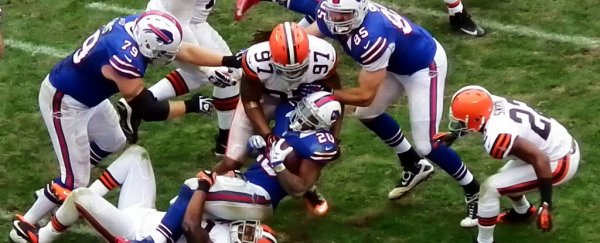An analysis of the brains of 111 deceased NFL players whose bodies were donated to science has revealed a shocking, grim pattern: all but one of them bore the signs of a serious, degenerative brain disease.
Chronic traumatic encephalopathy (CTE) is a form of progressive neurodegeneration linked with repeated blows to the head – and the new research shows that 99 percent of the NFL player brains examined showed evidence of this severe trauma.
In the largest study that's ever been conducted on individuals with CTE, researchers from Boston University analysed the brains of 202 deceased football players in total, who competed at various levels of the game.
This included high school, college, and semi-professional players, in addition to footballers from two professional leagues: the NFL and the Canadian Football League (CFL).
In all, CTE was diagnosed in 177 of these 202 players (87 percent) – a sobering statistic that shocked even the researchers.
"[It's] startling to be able to gather 177 examples of CTE," neuropathologist Ann McKee told NPR.
"While we still don't know what the incidence is in the general population or in the general population of football players, the fact that we were able to gather this many cases [in the study's time frame] says this disease is much more common than we previously realised."
The likelihood of developing CTE – and the extent of its severity – varied across the levels at which the players competed. Just three of the 14 high school players (21 percent) examined showed signs of the brain damage, and those that did only demonstrated mild pathology.
But the majority of college-level and above players had developed CTE, and more than half (56 percent) of college and semi-professionals showed severe signs of the condition.
At the top level, the findings were the grimmest. Among pro players with CTE, 86 percent demonstrated severe pathology – and this affected seven of the eight CFL players studied, and 110 out of the 111 NFL players.
The researchers aren't completely sure why CTE or its severity differed like this in the sample study, but it's possible that the condition becomes more likely and problematic depending on how long players play the game.
"We're seeing this [CTE] in a very large number that participated in football for many years," McKee told NPR.
"So while we don't know the exact risk and we don't know the exact number, we know this is a problem in football."
That point is worth emphasising. While some of the figures here are definitely a cause for serious concern, the researchers point out that we can't take the sample of player brains they analysed as representative of all football players.
All of the brains studied here were donated by the players or their families to scientific research. We can't be sure of why they did that, but it's possible they were motivated because of public awareness of CTE, or CTE symptoms demonstrated by the players urged them to come forward and participate.
Those symptoms begin with disorientation and headaches, but can develop to include memory loss and erratic behaviour, before progressing to dementia, aggression, and suicidal behaviour.
If the players involved here or their families experienced these kinds of things, it could have made them more likely to enrol in the brain donation program – skewing the results.
Because of this, the team urges caution in interpreting the high frequency of CTE in the findings.
But even with that disclaimer, the prevalence of brain damage revealed here has left the researchers in no doubt that football exacts a devastating toll on the minds of many who play it – and they argue that this is something we definitely need to talk about.
"It's impossible to ignore this anymore," McKee told The Boston Globe.
"To me this says that this [is] a public health problem, something that should concern parents and athletes. All the participants were exposed to a relatively similar type of repetitive head trauma while playing the same sport."
The findings are reported in JAMA.
